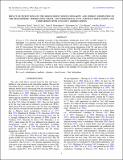| dc.contributor.author | Yang, Zhongwei | |
| dc.contributor.author | Liu, Ying D. | |
| dc.contributor.author | Richardson, John D. | |
| dc.contributor.author | Lu, Quanming | |
| dc.contributor.author | Huang, Can | |
| dc.contributor.author | Wang, Rui | |
| dc.date.accessioned | 2015-11-24T20:50:10Z | |
| dc.date.available | 2015-11-24T20:50:10Z | |
| dc.date.issued | 2015-08 | |
| dc.date.submitted | 2015-04 | |
| dc.identifier.issn | 1538-4357 | |
| dc.identifier.issn | 0004-637X | |
| dc.identifier.uri | http://hdl.handle.net/1721.1/100050 | |
| dc.description.abstract | Voyager 2 (V2) observed multiple crossings of the heliospheric termination shock (TS) on 2007 August 31–September 1 at a distance of 84 AU from the Sun. Here, for the first time, we present two-dimensional particle-in-cell (PIC) simulations of the TS self-consistently including pickup ions (PUIs), and compare the simulation results with V2 observations. We find that (1) PUIs play a key role in the energy dissipation of the TS, and most of the incident ion kinetic energy is transferred to the thermal energy of PUIs. The PIC simulation indicates that, for the upstream parameters chosen for V2 conditions, the density of PUIs is about 25% and the PUIs gain the largest fraction (approximately 86.6%) of downstream thermal pressure. (2) The simulated heliosheath ion distribution function is a superposition of a cold core formed by transmitted solar wind ions (SWIs), with the shoulders contributed by the hot reflected SWIs and directly transmitted PUIs, and the wings of the distribution dominated by the very hot reflected PUIs. The V2 Faraday cups observed the cool core of the distribution, and so they only saw the tip of the iceberg. (3) The nonstationarity of the shock front is mainly caused by ripples along the shock front which form even if the percentage of PUIs is high. These simulation results agree reasonably well with the V2 experimental data. The relevance of the shock front ripples to the multiple TS crossings observed by V2 is also discussed in this paper. | en_US |
| dc.description.sponsorship | National Natural Science Foundation (China) (Grant 41204106) | en_US |
| dc.description.sponsorship | National Natural Science Foundation (China) (Grant 41374173) | en_US |
| dc.description.sponsorship | China. Recruitment Program of Global Experts | en_US |
| dc.description.sponsorship | State Key Laboratories of China (Specialized Research Fund Y32612A24S) | en_US |
| dc.description.sponsorship | State Key Laboratories of China (Specialized Research Fund Y5262AA52S) | en_US |
| dc.description.sponsorship | Shanghai Science Foundation (12ZR1451500) | en_US |
| dc.language.iso | en_US | |
| dc.publisher | IOP Publishing | en_US |
| dc.relation.isversionof | http://dx.doi.org/10.1088/0004-637x/809/1/28 | en_US |
| dc.rights | Article is made available in accordance with the publisher's policy and may be subject to US copyright law. Please refer to the publisher's site for terms of use. | en_US |
| dc.source | IOP Publishing | en_US |
| dc.title | IMPACT OF PICKUP IONS ON THE SHOCK FRONT NONSTATIONARITY AND ENERGY DISSIPATION OF THE HELIOSPHERIC TERMINATION SHOCK: TWO-DIMENSIONAL FULL PARTICLE SIMULATIONS AND COMPARISON WITH VOYAGER 2 OBSERVATIONS | en_US |
| dc.type | Article | en_US |
| dc.identifier.citation | Yang, Zhongwei, Ying D. Liu, John D. Richardson, Quanming Lu, Can Huang, and Rui Wang. “IMPACT OF PICKUP IONS ON THE SHOCK FRONT NONSTATIONARITY AND ENERGY DISSIPATION OF THE HELIOSPHERIC TERMINATION SHOCK: TWO-DIMENSIONAL FULL PARTICLE SIMULATIONS AND COMPARISON WITH VOYAGER 2 OBSERVATIONS.” The Astrophysical Journal 809, no. 1 (August 5, 2015): 28. © 2015 The American Astronomical Society | en_US |
| dc.contributor.department | MIT Kavli Institute for Astrophysics and Space Research | en_US |
| dc.contributor.mitauthor | Richardson, John D. | en_US |
| dc.relation.journal | The Astrophysical Journal | en_US |
| dc.eprint.version | Final published version | en_US |
| dc.type.uri | http://purl.org/eprint/type/JournalArticle | en_US |
| eprint.status | http://purl.org/eprint/status/PeerReviewed | en_US |
| dspace.orderedauthors | Yang, Zhongwei; Liu, Ying D.; Richardson, John D.; Lu, Quanming; Huang, Can; Wang, Rui | en_US |
| mit.license | PUBLISHER_POLICY | en_US |
| mit.metadata.status | Complete | |
